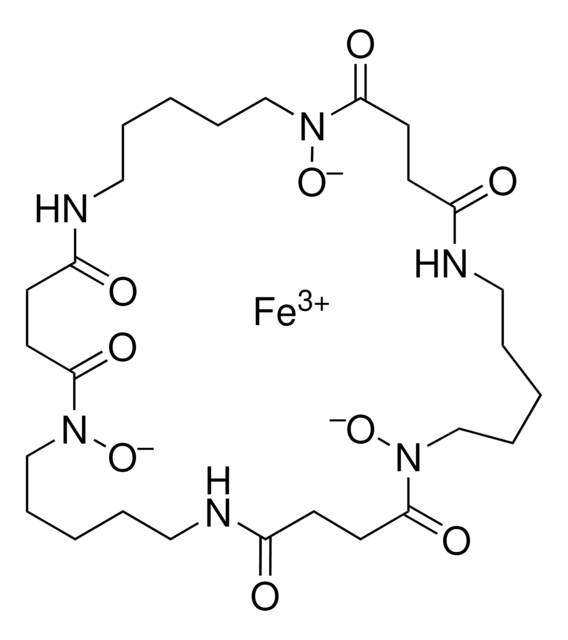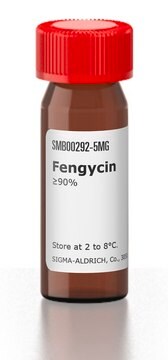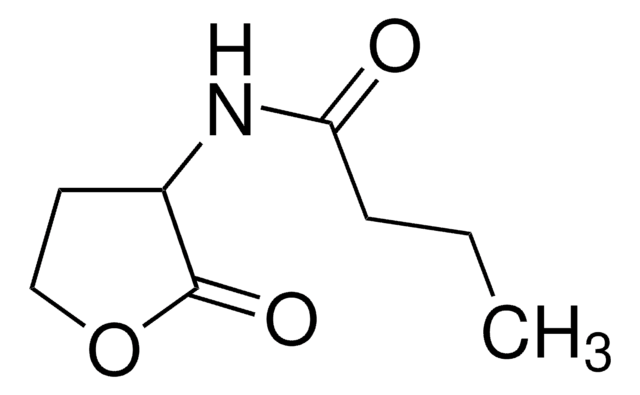P8124
Pyoverdines
from Pseudomonas fluorescens, >90% (HPLC)
Sinônimo(s):
Pyoverdine Detection, Pyoverdine Protein, Siderophore Protein
Faça loginpara ver os preços organizacionais e de contrato
About This Item
Código UNSPSC:
12352200
NACRES:
NA.32
Produtos recomendados
fonte biológica
Pseudomonas fluorescens
Nível de qualidade
Ensaio
>90% (HPLC)
Formulário
powder
solubilidade
H2O: ~10 mg/mL
Condições de expedição
wet ice
temperatura de armazenamento
−20°C
Procurando produtos similares? Visita Guia de comparação de produtos
Aplicação
Pyoverdines from Pseudomonas fluorescens has been used :
- in tryptophan fluorescence quenching to determine its binding to neutrophil-gelatinase-associated lipocalin (NGAL)
- to detect pyoverdine diffusion surrounding siderophore-conjugated monobactam (MB-1)-resistant colonies in chelexed, dialyzed Mueller-Hinton broth (CDMHB)
- for synchronous fluorescence spectra of purified pyoverdine
Ações bioquímicas/fisiológicas
Pyoverdines help in promoting plant growth by chelating iron and rendering it unavailable for plant pathogens. The ferri-pyoverdine complex acts as a signaling molecule inducing the production of secreted virulence factors in Pseudomonas aeruginosa.
Pyoverdines, also called pseuobactins and pyoverdins, are fluorescent siderophores that have high affinity for iron (1032 M-1), and are synthesized by fluorescent pseudomonads under iron-deficient growth conditions. Pyoverdines were shown to prevent iron toxicity produced by iron overload in hepatocyte cultures and effectively scavenges the hydroxyl and peroxyl radicals. Pyoverdines are effective in acquiring iron from transferrin and lactoferrin. Pyoverdines are also involved in the suppression of pythium-induced damping-off of tomato and promotion of growth in some higher plants.
forma física
Supplied as a mixture containing mainly the succinic acid (MW=1161), 2-hydroxy glutaramide (MW=1190), and succinamide (MW=1160) forms of pyoverdines.
produto relacionado
Nº do produto
Descrição
Preços
Código de classe de armazenamento
11 - Combustible Solids
Classe de risco de água (WGK)
WGK 3
Ponto de fulgor (°F)
Not applicable
Ponto de fulgor (°C)
Not applicable
Escolha uma das versões mais recentes:
Já possui este produto?
Encontre a documentação dos produtos que você adquiriu recentemente na biblioteca de documentos.
Os clientes também visualizaram
Antioxidant and free radical scavenging activities of the iron chelators pyoverdin and hydroxypyrid-4-ones in iron-loaded hepatocyte cultures: comparison of their mechanism of protection with that of desferrioxamine.
Morel I
Free Radical Biology & Medicine, 13(5), 499-508 (1992)
Adaptation-based resistance to siderophore-conjugated antibacterial agents by Pseudomonas aeruginosa.
Tomaras AP
Antimicrobial Agents and Chemotherapy, 57(9), 4197-4207 (2013)
Purification of Pyoverdines of Pseudomonas fluorescens 2-79 by Copper-Chelate Chromatography.
Xiao R and Kisaalita WS
Applied and Environmental Microbiology, 61(11), 3769-3774 (1995)
Biological activity of secondary metabolites produced by a strain of Pseudomonas fluorescens.
Boruah HP and Kumar BS
Folia Microbiologica, 47(4), 359-363 (2002)
Correction: Multicolor Whole-Cell Bacterial Sensing Using a Synchronous Fluorescence Spectroscopy-Based Approach.
PLoS ONE (2015)
Nossa equipe de cientistas tem experiência em todas as áreas de pesquisa, incluindo Life Sciences, ciência de materiais, síntese química, cromatografia, química analítica e muitas outras.
Entre em contato com a assistência técnica












